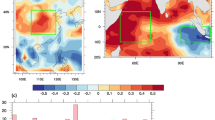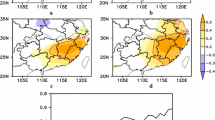Abstract
Using reanalysis data and snow cover data derived from satellite observations, respective influences of Indian Ocean Dipole (IOD) and El Niño/Southern Oscillation (ENSO) on the Tibetan snow cover in early winter are investigated. It is found that the snow cover shows a significant positive partial correlation with IOD. In the pure positive IOD years with no co-occurrences of El Niño, negative geopotential height anomalies north of India are associated with warm and humid southwesterlies to enter the plateau from the Bay of Bengal after rounding cyclonically and supply more moisture. This leads to more precipitation, more snow cover, and resultant lower surface temperature over the plateau. These negative geopotential height anomalies north of India are related to the equivalent barotropic stationary Rossby waves in the South Asian wave guide. The waves can be generated by the IOD-related convection anomalies over the western/central Indian Ocean. In contrast, in the pure El Niño years with no co-occurrences of the positive IOD, the anomalies of moisture supply and surface temperature over the plateau are insignificant, suggesting negligible influences of ENSO on the early winter Tibetan snow cover. Further analyses show that ENSO is irrelevant to the spring/early summer Tibetan snow cover either, whereas the IOD-induced snow cover anomalies can persist long from the early winter to the subsequent early summer.













Similar content being viewed by others
References
Alexander MA, Lau NC, Scott JD (2004) Broadening the atmospheric bridge paradigm: ENSO teleconnections to the tropical west Pacific-Indian Oceans over the seasonal cycle and to the North Pacific in summer. In: Wang C, Xie SP, Carton JA (eds) Earth’s climate: the ocean-atmosphere interaction. Geophysical Monograph, vol 147. AGU, Washington DC, pp 85–103
Ashok K, Guan Z, Yamagata T (2003) A look at the relationship between the ENSO and the Indian Ocean Dipole. J Meteorol Soc Jpn 81:41–56. doi:10.2151/jmsj.81.41
Blanford HF (1884) On the connection of the Himalayan snowfall with dry winds and seasons of droughts in India. Proc R Soc Lond 37:3–22. doi:10.1098/rspl.1884.0003
Barlow M, Hoell A, Colby F (2007) Examining the wintertime response to tropical convection over the Indian Ocean by modifying convective heating in a full atmospheric model. Geophys Res Lett. doi:10.1029/2007GL030043
Fasullo J (2004) A stratified diagnosis of the Indian Monsoon-Eurasian snow cover relationship. J Clim 17:1110–1122. doi:10.1175/1520-0442(2004)017<1110:ASDOTI>2.0.CO;2
Ferranti L, Molteni F (1999) Ensemble simulations of Eurasian snow-depth anomalies and their influence on summer Asian monsoon. Q J R Meteorol Soc 125:2597–2610. doi:10.1002/qj.49712555913
Guan Z, Yamagata T (2003) The unusual summer of 1994 in East Asia: IOD Teleconnections. Geophys Res Lett. doi:10.1029/2002GL016831
Hahn DJ, Shukla J (1976) An apparent relationship between Eurasian snow cover and Indian monsoon rainfall. J Atmos Sci 33:2461–2462. doi:10.1175/1520-0469(1976)033<2461:AARBES>2.0.CO;2
Kalnay E et al (1996) The NCEP/NCAR 40-year reanalysis project. Bull Am Meteorol Soc 77:437–471. doi:10.1175/1520-0477(1996)077<0437:TNYRP>2.0.CO;2
Kirtman BP, Shukla J (2000) Influence of the Indian summer monsoon on ENSO. Q J R Meteorol Soc 126:213–239
Kripalani RH (2007) A possible mechanism for the delayed impact of the Indian Ocean Dipole Mode on the East Asian Summer Monsoon. APCC [APEC (Asia-Pacific Economic Co-operation) Climate Center] Newsletter, Busan, South Korea, vol 2, No 4, 4–6 December 2007. http://www.apcc21.net
Kripalani RH, Kulkarni A (1999) Climatology and variability of historical Soviet snow depth data: some new perspectives in Snow-Indian Monsoon tele-connections. Clim Dyn 15:475–489. doi:10.1007/s003820050294
Kripalani RH, Kulkarni A, Sabade SS, Khandekor ML (2003) Western Himalayan snow cover and Indian summer monsoon rainfall: a re-examination with INSAT and NCEP/NCAR data. Theor Appl Climatol 74:1–18. doi:10.1007/s00704-002-0699-z
Kripalani RH, Oh JH, Kang JH, Sabade SS, Kulkarni A (2005) Extreme monsoons over East Asian: possible role of Indian Ocean Zonal Mode. Theor Appl Climatol 82:81–94. doi:10.1007/s00704-004-0114-z
Li PJ (1993) Characteristics of snow cover in western China. Acta Geogr Sin 48:505–514
Qin D, Liu S, Li P (2006) Snow cover distribution, variability, and response to climate change in western China. J Clim 19:1820–1833. doi:10.1175/JCLI3694.1
Rayner NA, et al (2003) Global analyses of sea surface temperature, sea ice, and night marine air temperature since the late nineteenth century. J Geophys Res. doi:10.1029/2002JD002670
Rodwell MJ, Hoskins B (1996) Monsoons and the dynamics of deserts. Q J R Meteorol Soc 122:1385–1404. doi:10.1002/qj.49712253408
Saji NH, Goswami BN, Vinayachandran PN, Yamagata T (1999) A dipole mode in the tropical Indian Ocean. Nature 401:360–363
Sardeshmukh P, Hoskins B (1988) The generation of global rotational flow by steady idealized tropical divergence. J Atmos Sci 45:1228–1251. doi:10.1175/1520-0469(1988)045<1228:TGOGRF>2.0.CO;2
Shaman J, Tziperman E (2005) The effect of ENSO on Tibetan Plateau snow depth: a stationary wave teleconnection mechanism and implications for the South Asian monsoons. J Clim 18:2067–2078. doi:10.1175/JCLI3391.1
Shukla J (1984) Predictability of time averages. Part II: The influence of the boundary forcing. In: Burridge DM, Kallen E (eds) Problems and prospects in long and medium range weather forecasting. Springer, Heidelberg, pp 155–206
Shukla J, Mooley DA (1987) Empirical prediction of the summer monsoon rainfall over India. Mon Weather Rev 115:695–703. doi:10.1175/1520-0493(1987)115<0695:EPOTSM>2.0.CO;2
Takaya K, Nakamura H (2001) A formulation of a phase-independent wave-activity flux for stationary and migratory quasigeostrophic eddies on a zonally varying basic flow. J Atmos Sci 58:608–627. doi:10.1175/1520-0469(2001)058<0608:AFOAPI>2.0.CO;2
Walker GT (1910) On the meteorological evidence for supposed changes of climate in India. Mem Indian Meteor 21:1–21
Wu TW, Qian ZA (2003) The relation between the Tibetan winter snow and the Asian summer monsoon and rainfall: an observational investigation. J Clim 16:2038–2051. doi:10.1175/1520-0442(2003)016<2038:TRBTTW>2.0.CO;2
Yamagata T, Behera SK, Luo JJ, Masson S, Jury MR, Rao SA (2004) Coupled ocean-atmosphere variability in the tropical Indian Ocean. In: Wang C, Xie SP, Carton JA (eds) Earth’s climate: the ocean–atmosphere interaction, vol 147. Geophysical Monograph. AGU, Washington DC, pp 189–212
Yamagata T, Masumoto Y (1989) A simple ocean-atmosphere coupled model for the origin of a warm El Nino Southern Oscillation event. Phil Trans R Soc Lond 329 A:225–236
Zhang Y, Li T, Wang B (2004) Decadal change of the spring snow depth over the Tibetan Plateau: the associated circulation and influence on the East Asian summer monsoon. J Clim 17:2780–2793. doi:10.1175/1520-0442(2004)017<2780:DCOTSS>2.0.CO;2
Acknowledgments
We thank Drs. H. Nakamura, Y. Masumoto, P. Chang, F.-F. Jin, S.-P. Xie and S. K. Behera for fruitful discussions. The present research is supported by the Japan Society for Promotion of Science through Grant-in-Aid for Scientific Research (B) 20340125 and Sumitomo Foundation. The first author has been supported by the scholarship for foreign students offered by Ministry of Education, Culture, Sports, Science and Technology, Japan.
Author information
Authors and Affiliations
Corresponding author
Rights and permissions
About this article
Cite this article
Yuan, C., Tozuka, T., Miyasaka, T. et al. Respective influences of IOD and ENSO on the Tibetan snow cover in early winter. Clim Dyn 33, 509–520 (2009). https://doi.org/10.1007/s00382-008-0495-2
Received:
Accepted:
Published:
Issue Date:
DOI: https://doi.org/10.1007/s00382-008-0495-2




